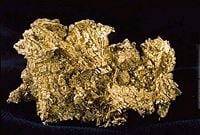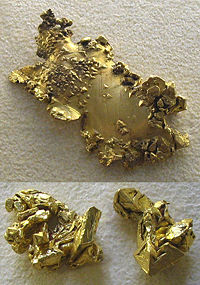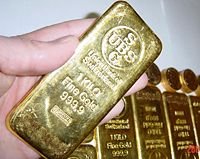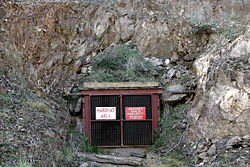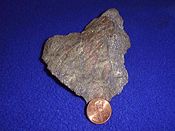Gold
- For other uses, see Gold (disambiguation).
Gold is a shiny yellow metal that has long been highly valued and regarded as a symbol for purity, permanence, and royalty. It occurs as nuggets or grains in rocks and alluvial deposits and does not react with most chemicals.
| ||||||||||||||||||||||||||||||||||||||||
| General | ||||||||||||||||||||||||||||||||||||||||
|---|---|---|---|---|---|---|---|---|---|---|---|---|---|---|---|---|---|---|---|---|---|---|---|---|---|---|---|---|---|---|---|---|---|---|---|---|---|---|---|---|
| Name, Symbol, Number | gold, Au, 79 | |||||||||||||||||||||||||||||||||||||||
| Chemical series | transition metals | |||||||||||||||||||||||||||||||||||||||
| Group, Period, Block | 11, 6, d | |||||||||||||||||||||||||||||||||||||||
| Appearance | metallic yellow 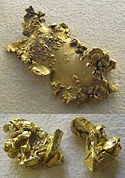
| |||||||||||||||||||||||||||||||||||||||
| Atomic mass | 196.966569(4) g/mol | |||||||||||||||||||||||||||||||||||||||
| Electron configuration | [Xe] 4f14 5d10 6s1 | |||||||||||||||||||||||||||||||||||||||
| Electrons per shell | 2, 8, 18, 32, 18, 1 | |||||||||||||||||||||||||||||||||||||||
| Physical properties | ||||||||||||||||||||||||||||||||||||||||
| Phase | solid | |||||||||||||||||||||||||||||||||||||||
| Density (near r.t.) | 19.3 g/cm³ | |||||||||||||||||||||||||||||||||||||||
| Liquid density at m.p. | 17.31 g/cm³ | |||||||||||||||||||||||||||||||||||||||
| Melting point | 1337.33 K (1064.18 °C, 1947.52 °F) | |||||||||||||||||||||||||||||||||||||||
| Boiling point | 3129 K (2856 °C, 5173 °F) | |||||||||||||||||||||||||||||||||||||||
| Heat of fusion | 12.55 kJ/mol | |||||||||||||||||||||||||||||||||||||||
| Heat of vaporization | 324 kJ/mol | |||||||||||||||||||||||||||||||||||||||
| Heat capacity | (25 °C) 25.418 J/(mol·K) | |||||||||||||||||||||||||||||||||||||||
| ||||||||||||||||||||||||||||||||||||||||
| Atomic properties | ||||||||||||||||||||||||||||||||||||||||
| Crystal structure | cubic face centered | |||||||||||||||||||||||||||||||||||||||
| Oxidation states | 3, 1 (amphoteric oxide) | |||||||||||||||||||||||||||||||||||||||
| Electronegativity | 2.54 (Pauling scale) | |||||||||||||||||||||||||||||||||||||||
| Ionization energies | 1st: 890.1 kJ/mol | |||||||||||||||||||||||||||||||||||||||
| 2nd: 1980 kJ/mol | ||||||||||||||||||||||||||||||||||||||||
| Atomic radius | 135 pm | |||||||||||||||||||||||||||||||||||||||
| Atomic radius (calc.) | 174 pm | |||||||||||||||||||||||||||||||||||||||
| Covalent radius | 144 pm | |||||||||||||||||||||||||||||||||||||||
| Van der Waals radius | 166 pm | |||||||||||||||||||||||||||||||||||||||
| Miscellaneous | ||||||||||||||||||||||||||||||||||||||||
| Magnetic ordering | no data | |||||||||||||||||||||||||||||||||||||||
| Electrical resistivity | (20 °C) 22.14 nΩ·m | |||||||||||||||||||||||||||||||||||||||
| Thermal conductivity | (300 K) 318 W/(m·K) | |||||||||||||||||||||||||||||||||||||||
| Thermal expansion | (25 °C) 14.2 µm/(m·K) | |||||||||||||||||||||||||||||||||||||||
| Speed of sound (thin rod) | (r.t.) (hard-drawn) 2030 m/s | |||||||||||||||||||||||||||||||||||||||
| Speed of sound (thin rod) | (r.t.) 78 m/s | |||||||||||||||||||||||||||||||||||||||
| Shear modulus | 27 GPa | |||||||||||||||||||||||||||||||||||||||
| Bulk modulus | 220 GPa | |||||||||||||||||||||||||||||||||||||||
| Poisson ratio | 0.44 | |||||||||||||||||||||||||||||||||||||||
| Mohs hardness | 2.5 | |||||||||||||||||||||||||||||||||||||||
| Vickers hardness | 216 MPa | |||||||||||||||||||||||||||||||||||||||
| Brinell hardness | 2450 MPa | |||||||||||||||||||||||||||||||||||||||
| CAS registry number | 7440-57-5 | |||||||||||||||||||||||||||||||||||||||
| Notable isotopes | ||||||||||||||||||||||||||||||||||||||||
| ||||||||||||||||||||||||||||||||||||||||
History
Gold (Sanskrit jval, Greek χρυσος [khrusos], Latin aurum for "shining dawn", Anglo-Saxon gold, Chinese 金 [jīn],Japanese 金 [kin]) is a precious metal that has been known and highly valued since prehistoric times. Early peoples used it mainly for ornamentation and rituals. Gold is described in Egyptian hieroglyphs dating back to 2600 B.C.E., and it is mentioned several times in the Hebrew scriptures.
Egypt and Nubia had the resources to make them major gold-producing areas for much of history. The southeast corner of the Black Sea was famed for its gold. Exploitation is said to date from the time of Midas, and this gold was important in the establishment of what was probably the world's earliest coinage in Lydia between 643 and 630 B.C.E.
The European exploration of the Americas was fueled in no small part by reports of the gold ornaments displayed in great profusion by Native American peoples, especially in Central America, Peru, and Colombia.
Gold in antiquity was relatively easy to obtain geologically; however, 75% of all gold ever produced has been extracted since 1910.[1] It has been estimated that all the gold in the world that has ever been refined would form a single cube 20 m (66 ft) a side.
The primary goal of the alchemists was to produce gold from other substances, such as lead — presumably by the interaction with a mythical substance called the philosopher's stone. Although they never succeeded in this attempt, the alchemists promoted an interest in what can be done with substances, and this laid a foundation for today's chemistry. Their symbol for gold was the circle with a point at its center (☉), which was also the astrological symbol, the Egyptian hieroglyph and the ancient Chinese character for the Sun (now 日). For modern attempts to produce artificial gold, see gold synthesis.
During the 19th century, gold rushes occurred whenever large gold deposits were discovered, including the California, Colorado, Otago, Australia, Witwatersrand, Black Hills, and Klondike gold rushes.
Because of its historically high value, much of the gold mined throughout history is still in circulation in one form or another.
Occurrence
Gold is widely distributed in the Earth's crust, at a background level of 0.03 g/1000 kg (0.03 ppm by weight). In sea water, its concentration ranges between 0.1 and 2 mg/t (0.1 to 2 ppb by weight), depending on sample location.
Given its relative chemical inertness, gold usually occurs as the native metal or alloy. Occasionally, it may be found in the form of large accumulations (nuggets), but it is more often found as minute grains. These grains may lie between mineral grain boundaries or as inclusions within minerals.
The primary source of gold is usually igneous rocks or surface concentrations. A deposit usually needs some form of secondary enrichment to form an economically viable ore deposit: either chemical or physical processes like erosion or dissolution, or more generally metamorphism, which concentrates the gold in sulfide minerals or quartz.
There are several primary deposit types; common ones are termed reef or vein. Primary deposits can be weathered and eroded, with most of the gold being transported into stream beds where it congregates with other heavy minerals to form placer deposits. In all these deposits, the gold remains in its native form. In addition, sedimentary black shale and limestone deposits contain finely disseminated gold and other platinum group metals.
Common gold associations are quartz, often as veins, and sulfide minerals. The most common sulfide associations are pyrite, chalcopyrite, galena, sphalerite, arsenopyrite, stibnite and pyrrhotite. Rarer mineral associations are petzite, calaverite, sylvanite, muthmannite, nagyagite and krennerite. Hydrothermal ore deposits of gold occur in metamorphic rocks and igneous rocks; alluvial deposits and placer deposits originate from these sources.
Recent research shows that microbes play an important role in the formation of gold deposits. They transport and precipitate gold to form grains and nuggets that collect in alluvial deposits. [2]
Physical and chemical characteristics
Gold is a chemical element that has the symbol Au (from the Latin word aurum) and atomic number 79. In the periodic table, it is placed in the same family (Group 11 or 1B) as copper and silver.
Although the usual color of gold is yellow, its finely divided form may appear black or ruby-colored, while colloidal solutions are intensely colored and often purple.
Gold is the most malleable and ductile metal—a single gram can be beaten into a sheet of one square meter, or an ounce into 300 square feet. It is a good conductor of heat and electricity.
Alloys of gold are often prepared to increase its strength or create a range of exotic colors. Adding copper yields a redder metal; iron, blue; silver, green; aluminum, purple; and platinum, white. When natural bismuth is added to alloys with silver, the resultant mixture is black. Native gold usually contains 8–10% silver, but often much more. Alloys with a silver content over 20% are called electrum. As the amount of silver increases, the color becomes whiter and the specific gravity, lower.
and is not affected by air and most reagents. Heat, moisture, oxygen, and most corrosive agents have very little chemical effect on gold, making it well-suited for use in coins and jewelry. It does, however, react with halogens and aqua regia (a mixture of nitric acid and hydrochloric acid in the ratio 1:3).
Common oxidation states of gold include +1 (gold(I) or aurous compounds) and +3 (gold(III) or auric compounds). Gold ions in solution are readily reduced and precipitated out as gold metal by the addition of virtually any other metal as the reducing agent. The added metal is oxidized and dissolves, allowing the gold to be displaced from solution and recovered as a solid precipitate.
Although gold is a noble metal, it can form many compounds, auric chloride (AuCl3) and chlorauric acid (HAuCl4) being the most common. Gold compounds can be aurous (univalent, +1) or auric (trivalent, +3). Gold also can under extreme conditions form a +5 state with fluorine (gold pentafluoride, AuF5), as well as (unusually for a metal), a -1 state. Such compounds containing the Au- anion are called aurides and include caesium auride, CsAu, rubidium auride, RbAu, and tetramethylammonium auride, (CH3)4N+ Au-.
Gold also forms:
- The AuCl4- ion after dissolving in aqua regia
- Gold halides (F,Cl,Br,I)
- Gold chalcogenides (O, S, Se,Te)
- Gold cluster compounds
- Gold hydrazide: an olive-green powder, AuN2H3, one of several explosive compounds known archaically as aurum fulminans
Gold comes in one stable isotope and 18 radioisotopes. In the latter group, Au-195 is the most stable, with a half-life of 186 days.
Notable characteristics
Gold is a metallic element with a characteristic yellow color, but can also be black or ruby when finely divided, while colloidal solutions are intensely colored and often purple. These colors are the result of gold's plasmon frequency lying in the visible range, which causes red and yellow light to be reflected, and blue light to be absorbed. Only silver colloids exhibit the same interactions with light, albeit at a shorter frequency, making silver colloids yellow in color.
It is the most malleable and ductile metal known; a single gram can be beaten into a sheet of one square metre, or an ounce into 300 square feet. A soft metal, gold will readily form alloys with many other metals. This can be done to increase its strength, or create several exotic colors, sold for instance in the western United States to the tourist trade as "Black Hills" gold. Adding copper yields a redder metal, iron blue, Silver produces green, aluminium purple, platinum metals white, and natural bismuth together with silver alloys produce black. Native gold contains usually eight to ten per cent silver, but often much more — alloys with a silver content over 20% are called electrum. As the amount of silver increases, the color becomes whiter and the specific gravity lower.
Gold is a good conductor of heat and electricity, and is not affected by air and most reagents. Heat, moisture, oxygen, and most corrosive agents have very little chemical effect on gold, making it well-suited for use in coins and jewelry; conversely, halogens will chemically alter gold, and aqua regia dissolves it.
Common oxidation states of gold include +1 (gold(I) or aurous compounds) and +3 (gold(III) or auric compounds). Gold ions in solution are readily reduced and precipitated out as gold metal by the addition of virtually any other metal as the reducing agent. The added metal is oxidized and dissolves allowing the gold to be displaced from solution and be recovered as a solid precipitate.
Recent research undertaken by Frank Reith of the Australian National University shows that microbes play an important role in the formation of gold deposits, transporting and precipitating gold to form grains and nuggets that collect in alluvial deposits. [3]
Applications
Pure gold is too soft for ordinary use and is hardened by alloying with silver, copper, and other metals. Gold and its many alloys are most often used in jewelry, coinage and as a standard for monetary exchange in many countries. Because of its high electrical conductivity and resistance to corrosion and other desirable combinations of physical and chemical properties, gold also emerged in the late 20th century as an essential industrial metal.
- Gold can be made into thread and used in embroidery.
- Gold performs critical functions in computers, communications equipment, spacecraft, jet aircraft engines, and a host of other products.
- The resistance to oxidation of gold has led to its widespread use as thin layers electroplated on the surface of electrical connectors to ensure a good connection.
- Gold is used in restorative dentistry especially in tooth restorations such as crowns and bridges.
- Colloidal gold (a gold nanoparticle) is an intensely colored solution that is currently studied in many labs for medical, biological and other applications. It is also the form used as gold paint on ceramics prior to firing.
- Chlorauric acid is used in photography for toning the silver image.
- Gold(III) chloride is used as a catalyst in organic chemistry. It is also the usual starting point for making other gold compounds.
- Gold is used as a coating enabling biological material to be viewed under a scanning electron microscope.
- Many competitions and honors, such as the Olympics and the Nobel Prize, award a gold medal to the winner (with silver to the second-place finisher, and bronze to the third.)
- Since it is a good reflector of both infrared and visible light, it is used for the protective coatings on many artificial satellites.
- Disodium aurothiomalate is a treatment for rheumatoid arthritis (administered intramuscularly). It inhibits lymphocyte proliferation, lysosomal enzyme release, the release of reactive oxygen species from macrophages, and IL-1 production. However, it can also cause photosensitive rashes, gastrointestinal disturbance, and kidney damage.
- The gold isotope Au-198, (half-life: 2.7 days) is used in some cancer treatments and for treating other diseases.
- Gold flake is used on and in some gourmet sweets and drinks. Called varak or (varaq) in India. Having no reactivity it adds no taste but is taken as a delicacy. Some use it as an excuse to create super-expensive delicacies ($1,000 cocktails). For similar reasons, it also used as the basis for some superstitious, over the top, health claims. Only the salts and radioisotopes (mentioned above) have any evidence of medicinal value.
- White gold (an alloy of gold with platinum, palladium, nickel, and/or zinc) serves as a substitute for platinum.
- Green gold (a gold/silver alloy) is used in specialized jewelry while gold alloys with copper (reddish color) are more widely used for that purpose (rose gold).
Value
Like other precious metals, gold is measured by troy weight and by grams. When it is alloyed with other metals the term carat or karat is used to indicate the amount of gold present, with 24 carats being pure gold and lower ratings proportionally less. The purity of a gold bar can also be expressed as a decimal figure ranging from 0 to 1, known as the millesimal fineness, such as 0.995.
The price of gold is determined on the open market, but a procedure known as the Gold Fixing in London, originating in 1919, provides a twice-daily benchmark figure to the industry.
Historically gold was used to back currency in an economic system known as the gold standard in which one unit of currency was equivalent to a certain weight of gold. As part of this system, governments and central banks attempted to control the price of gold by setting values at which they would exchange it for currency. For a long period the United States government set the price of gold at $20.67 per troy ounce ($664.56/kg) but in 1934 the price of gold was set at $35.00 per troy ounce ($1125.27/kg). By 1961 it was becoming hard to maintain this price, and a pool of US and European banks began to act together to defend the price against market forces.
On March 17 1968, economic circumstances caused the collapse of the gold pool, and a two-tiered pricing scheme was established whereby gold was still used to settle international accounts at the old $35.00 per troy ounce ($1.13/g) but the price of gold on the private market was allowed to fluctuate; this two-tiered pricing system was abandoned in 1975 when the price of gold was left to find its free-market level. Central banks still hold historical gold reserves as a reserve asset although the level has generally been declining. The largest gold depository in the world is that of the U.S. Federal Reserve Bank, in New York.
Since 1968 the price of gold on the open market has ranged widely, with a record high of $850/oz ($27,300/kg) on 21 January 1980, to a low of $252.90/oz ($8,131/kg) on 21 June 1999 (London Fixing). Prices have risen to the $500/oz mark in late 2005, due to a depreciation of the US dollar and inflation due to rising energy costs.
Gold and the money supply
In January 1959 US M3 money supply was $288.8 billion, and the Official Gold Holdings of the United States was then 17,335.1 Tonnes, or about 557 million ounces (there are 32,150.7 Troy Ounces in a Tonne). That means that in 1959, there were $518 in circulation for every ounce of gold reserves held by the USA. Although the theoretical price should then have been $518 per ounce, the actual price, as fixed under the gold standard was only $35 an ounce.
By August 2005, the US M3 money supply had risen to $9,873.9 billion, whilst at the same time the Official Gold Holdings of the United States had fallen to just 8,133.5 Tonnes, or about 261 million Troy Ounces. This means that today, in 2005, there are $37,831 in circulation for every ounce of gold held by the United States.
The above numbers show the falling influence of gold in the monetary system of the world today. Goldbugs believe, or even hope, that one day gold's importance will return as the printing of paper money gets out of control and we end in a hyper-inflationary fiat money collapse.
Restrictions on gold ownership
Because of its use as a reserve store of value, the possession of gold is sometimes restricted or banned. Within the United States, the private possession of gold except as jewelry and coin collecting was banned between 1933 and 1975. President Franklin D. Roosevelt expropriated gold by Executive Order 6102, and President Richard Nixon closed the gold window by which foreign countries could exchange American dollars for gold at a fixed rate.
Return of a gold standard?
In the first few years of the 21st century, reports started to circulate that Malaysia was planning a return to the gold standard — to issue and use gold dinars as currency in international trade. The purported purpose of this move would be to reduce dependence on the United States dollar as a reserve currency, and to establish a non-debt-backed currency in accord with Islamic law against the charging of interest. [4] Nonetheless, gold dinar currency has not yet emerged. [5] [6]
Gold in investment portfolios
As a tangible investment gold is sometimes held as part of a portfolio because over the long term gold has an extensive history of maintaining its value. It has in the last century gained ground in relation to fiat currencies owing to inflation. Gold becomes particularly desirable in times of extremely weak confidence and during hyperinflation because gold maintains its value even as fiat money becomes worthless. People who enjoy investing in gold are known as goldbugs.
Futures contracts based on gold currently trade on various exchanges around the world. In the US this occurs primarily on COMEX (Commodity Exchange) which is a subsidiary of the New York Mercantile Exchange. Speculation about the future price of gold and other commodities is carried on at COMEX. Recently, gold-based ETFs like GLD have emerged as a more convenient investment vehicle.
In some countries such as Switzerland, it is possible to hold physical gold as part of an investment portfolio, due to the absence of taxes and narrow bid-ask spreads, however in other countries portfolio managers sometimes hold gold shares or gold bullion securities as a proxy for the metal itself. Exchange Traded Funds such as Gold Bullion Securities are securities sponsored by the World Gold Council and which are fully backed up by allocated gold held by a custodian. The main Gold Bullion Securities are as follows:
- New York Stock Exchange (NYSE), Symbol:GLD (Streettracks Gold Shares, ISIN No. US8633071043)
- London Stock Exchange (LSE) Symbol GBS (Gold Bullion Securities ISIN No. GB00B00FHZ82)
- Euronext France Symbol:GBS (Gold Bullion Securities ISIN No. GB00B00FHZ82 )
- Australian Stock Exchange (ASX), Symbol:GOLD (Gold Bullion Securities ISIN No. AU00000GOLD7)
- Johannesburg Securities Exchange (JSE), Symbol:GLD (New Gold Debentures ISIN No. ZAE000060067 )
Production
Economic gold extraction can be achieved from ore grades as little as 0.5 g/1000 kg (0.5 ppm) on average in large easily mined deposits, typical ore grades in open-pit mines are 1–5 g/1000 kg (1-5 ppm), ore grades in underground or hard rock mines are usually at least 3 g/1000 kg (3 ppm) on average. Ore grades of 30 g/1000 kg (30 ppm) are usually needed before gold is visible to the naked eye, therefore in most gold mines you will not see any gold. It is claimed, that all the gold that has been mined throughout the history of mankind could be incorporated in a solid ball with a diameter of 27 metres.
Since the 1880s South Africa has been the source for a large proportion of the world's gold supply. Production in 1970 accounted for 79% of the world supply, producing about 1,000 tonnes, however production in 2004 was 342 tonnes. This decline was due to the increasing difficulty of extraction and changing economic factors affecting the industry in South Africa.
The city of Johannesburg was built atop the world's greatest gold finds. Gold fields in the Orange Free State and the Transvaal are deep and require the world's deepest mines. The Second Boer War of 1899–1901 between the British Empire and the white Boers was at least partly over the rights of miners and possession of the gold wealth in South Africa.
Other major producers are Canada, United States and Western Australia. Mines in South Dakota and Nevada supply two-thirds of gold used in the United States. Siberian regions of the USSR also used to be significant in the global gold mining industry. Kolar Gold Fields in India is another example of a city being built on the greatest gold deposits in India. In South America, the controversial project Pascua Lama aims at exploitation of rich fields in the high mountains of Atacama, at the border between Chile and Argentina.
The idea of producing gold out of lesser metals or other cheap substances has fascinated people throughout the centuries. Scientists, kings and charlatans obsessed with the secret art of alchemy accidentally invented practically useful materials (e.g. porcelain), while searching in vain for the philosopher's stone, which was supposed to turn mercury into gold. Modern science has since proven the impossibility of making gold from other elements via chemical reactions.
However, it is possible to obtain infinitesimally small amounts of gold by artificial nuclear transformations in particle accelerators The gold isotopes produced would likely be radioactive. No economically feasible method to manufacture gold artificially has been found and published yet. The possibility of cheap man-made gold would have unforeseen economic and political consequences.
The world's oceans hold a vast amount of gold, but in very low concentrations (perhaps 1-2 parts per billion). Fritz Haber (the German inventor of the Haber process) attempted commercial extraction of gold from sea water in an effort to help pay Germany's reparations following the First World War. Unfortunately, his assessment of the concentration of gold in sea water was unduly high, probably due to sample contamination. The effort produced little gold and cost the German government far more than the commercial value of the gold recovered. No commercially viable mechanism for performing gold extraction from sea water has yet been identified.
Compounds/isotopes
Although gold is a noble metal, it can form various compounds in which it has a cationic form, namely, Au+1 (aurous form) or Au+3 (auric form). The most common compounds of gold are auric chloride (AuCl3) and chlorauric acid (HAuCl4). Under extreme conditions, it combines with fluorine to take a +5 state, forming gold pentafluoride (AuF5).
Unusually for a metal, gold occasionally forms compounds in which it is an anion, Au-1. Examples are cesium auride (CsAu), rubidium auride (RbAu), and tetramethylammonium auride, (CH3)4N+ Au-.
Gold also forms:
- The AuCl4- ion after dissolving in aqua regia
- Gold halides (F,Cl,Br,I)
- Gold chalcogenides (O, S, Se,Te)
- Gold cluster compounds
- Gold hydrazide: an olive-green powder, AuN2H3, one of several explosive compounds known archaically as aurum fulminans
There is only one stable isotope of gold, and 18 radioisotopes with Au-195 being the most stable with a half-life of 186 days.
Precautions
The human body doesn't absorb gold very well, thus compounds of gold are not normally very toxic. Liver and kidney damage has, however, been reported for up to 50% of arthritis patients treated with gold-containing drugs. Gold used in dentistry is widely regarded as the safest form of restorative material, as well as the most successful.
Symbolism
Historically, gold has been associated with royalty, sanctity, and durability. The New Testament records that gold was one of the gifts offered by the three magi who visited the newborn Jesus. Later, Christian kings wore golden crowns to symbolize their divinely inspired authority. Also, various religious rituals have involved the use of items made of gold. The tombs of the pharaohs of ancient Egypt were filled with items made of or plated with gold.
Wedding rings are traditionally made of gold, as a metaphor for the unchanging commitment of the partners in marriage. Also, gold is associated with notable anniversaries, particularly in a 50-year cycle, such as the golden wedding anniversary or golden jubilee.
Gold medals and decorations are often used to honor those who have made great contributions to society or have won great competitions. Examples are medals awarded to winners of the Nobel Prize and champions in the Olympic Games. Also, many award statuettes are plated in gold, such as those given at the Academy Awards, the Emmy Awards, and the British Academy Film Awards.
A person who is particularly kind-hearted and generous is said to have a "heart of gold." The eminent orator John Chrysostom was said to have a "mouth of gold with a silver tongue."
On the other hand, hearkening back to the time of Moses, worshipping the Golden Calf has become a symbol of idolatry and revolt against God. Native Americans of the Sioux tribe called gold "the yellow metal that makes the white man crazy." In Communist propaganda, the gold pocket watch and its fastening gold chain were classified as accessories of the class enemy, namely, the bourgeoisie and industrial tycoons.
ReferencesISBN links support NWE through referral fees
See also
- Gold prospecting
- Gold as an investment
- Colloidal gold
- Socialism and Gold
- 22/22k
External links
- WebElements.com – Gold (also used as a reference)
- Mineral Galleries - Native Gold
- Getting Gold 1898 book
- BBC - h2g2 - Gold
- Silver Colloids – A Brief History of the Health Support Uses of Gold
af:Goud bg:Злато ca:Or cs:Zlato cy:Aur da:Guld de:Gold et:Kuld es:Oro eo:Oro fr:Or hr:Zlato io:Oro id:Emas is:Gull it:Oro he:זהב ku:Zêr la:Aurum lv:Zelts lt:Auksas lb:Gold li:Goud hu:Arany ms:Emas nl:Goud ja:金 no:Gull nn:Gull oc:Aur pl:Złoto pt:Ouro ru:Золото simple:Gold sk:Zlato sl:Zlato sr:Злато fi:Kulta sv:Guld ta:தங்கம் th:ทองคำ vi:Vàng tr:Altın uk:Золото zh:金
Credits
New World Encyclopedia writers and editors rewrote and completed the Wikipedia article in accordance with New World Encyclopedia standards. This article abides by terms of the Creative Commons CC-by-sa 3.0 License (CC-by-sa), which may be used and disseminated with proper attribution. Credit is due under the terms of this license that can reference both the New World Encyclopedia contributors and the selfless volunteer contributors of the Wikimedia Foundation. To cite this article click here for a list of acceptable citing formats.The history of earlier contributions by wikipedians is accessible to researchers here:
The history of this article since it was imported to New World Encyclopedia:
Note: Some restrictions may apply to use of individual images which are separately licensed.

